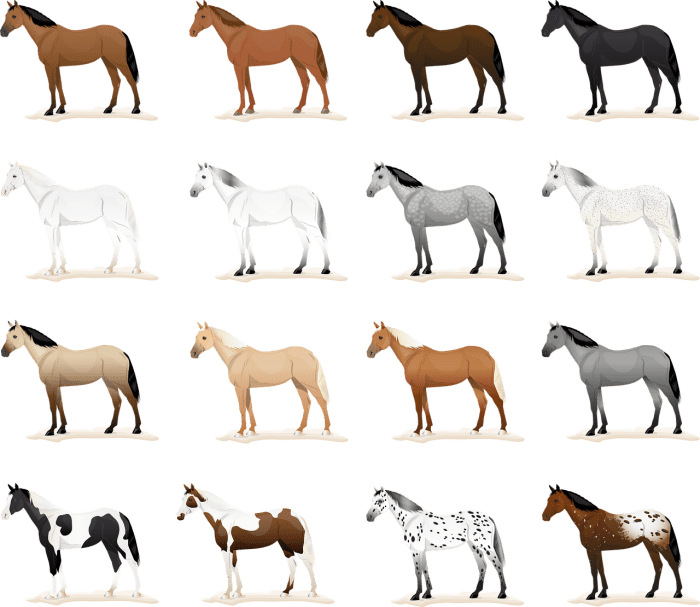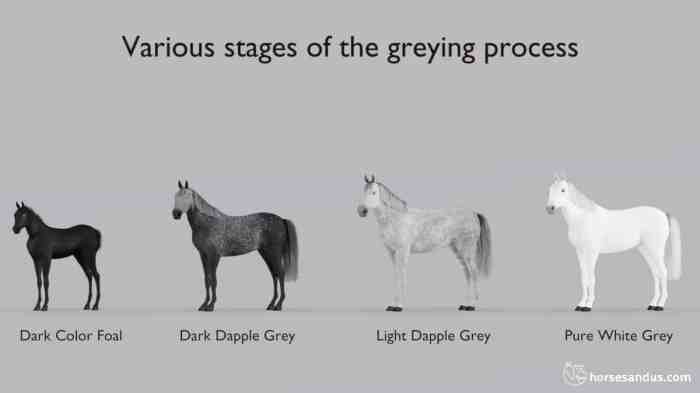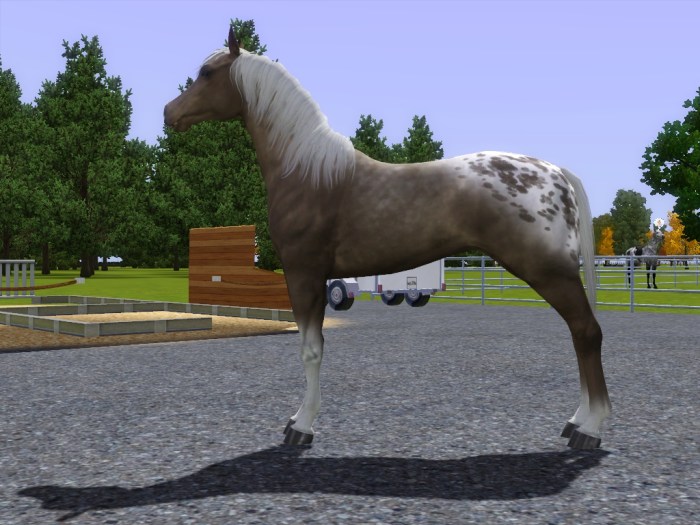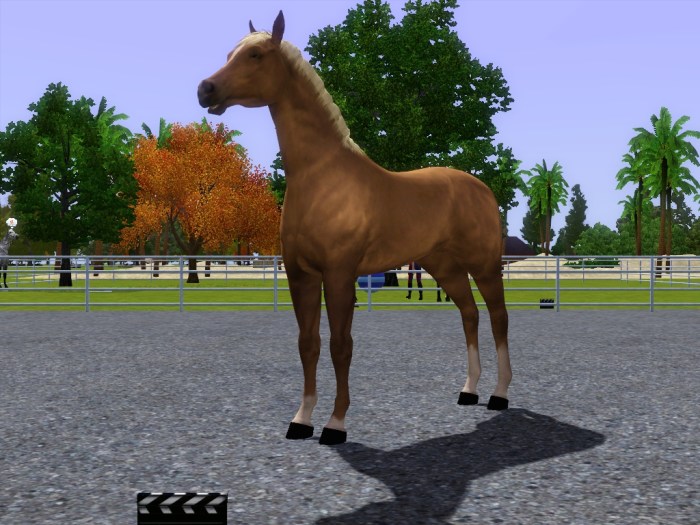Horse with a sprinkled coat – Unveiling the captivating world of horses adorned with sprinkled coats, we embark on a journey to explore their unique characteristics, genetic origins, historical significance, and artistic representations. Prepare to be mesmerized by the beauty and allure of these extraordinary creatures.
Sprinkled coats, an intriguing spectacle in the equine world, exhibit a captivating array of patterns and colors that set them apart. From the mesmerizing leopard complex to the striking sabino and the delicate snowflake, these coats showcase nature’s artistry in all its glory.
Physical Characteristics

Horses with sprinkled coats possess distinctive patterns and colorations that set them apart from other equines. These patterns are caused by a genetic mutation that affects the distribution of pigment in their coats.
Types of Sprinkled Coat Patterns
There are several types of sprinkled coat patterns, each with its unique characteristics:
- Leopard complex:This pattern is characterized by large, irregular spots of dark color on a lighter base coat. The spots can vary in size and shape, and they may be solid or have a roaned appearance.
- Sabino:Sabino horses have white markings that are typically located on the face, legs, and belly. These markings can be large or small, and they may have a roaned or splashed appearance.
- Snowflake:Snowflake horses have small, white spots that are evenly distributed over their entire body. These spots may be round or oval, and they may have a frosted or speckled appearance.
Breeds with Sprinkled Coats
Several horse breeds commonly exhibit sprinkled coats, including:
- Appaloosa
- Paint Horse
- American Quarter Horse
- Arabian
- Thoroughbred
These horses come in a wide range of colors, including bay, black, brown, and gray. The sprinkled coat patterns can enhance the beauty and uniqueness of these horses, making them highly sought after by breeders and enthusiasts.
Genetics
Sprinkled coat patterns in horses are determined by genetics, specifically by the interaction of dominant and recessive genes. Dominant genes are those that are expressed even when paired with a recessive gene, while recessive genes are only expressed when paired with another recessive gene.
Inheritance Patterns
The inheritance pattern of sprinkled coat patterns depends on the specific genes involved. In some cases, a single dominant gene may be responsible for the sprinkled pattern, while in other cases, a combination of dominant and recessive genes may be required.
- Homozygous dominant (DD):Horses with two copies of the dominant gene will have a sprinkled coat pattern.
- Heterozygous dominant (Dd):Horses with one copy of the dominant gene and one copy of the recessive gene will also have a sprinkled coat pattern.
- Homozygous recessive (dd):Horses with two copies of the recessive gene will not have a sprinkled coat pattern.
Breed History

The origins of horse breeds with sprinkled coats can be traced back to ancient times. Archaeological evidence suggests that horses with spotted or speckled coats existed as early as the Bronze Age, around 3000 BCE. These early horses were likely domesticated from wild horses that roamed the steppes of Central Asia.
Over time, different coat patterns developed in different regions of the world. In Europe, horses with leopard-spotted coats, known as Appaloosas, were prized by Native American tribes. In the Middle East, horses with sabino markings, characterized by large white patches, were favored by Arabian breeders.
Just like a horse with a sprinkled coat, the letters in “t h r o a t” can be rearranged to form different words. For instance, you can unscramble them to get t h r o a t , which means the passage at the back of the mouth and nose.
The versatility of words is as captivating as the beauty of a horse with a coat of many colors.
In Asia, horses with roan coats, a mixture of white and colored hairs, were common in Mongolia and China.
Cultural Significance
Sprinkled coats have held cultural significance in various regions throughout history. In some cultures, horses with spotted or speckled coats were considered sacred or lucky. In other cultures, they were associated with strength and courage. For example, in ancient Greece, horses with leopard-spotted coats were often depicted in art and mythology as symbols of the god Apollo.
Care and Grooming: Horse With A Sprinkled Coat

Maintaining a sprinkled coat requires specific care and grooming practices. These horses benefit from regular brushing and bathing to remove dirt and debris and maintain their coat’s health.
Grooming Techniques
- Regular Brushing:Use a soft-bristled brush to remove loose hair, dirt, and debris. Brush in the direction of hair growth, starting from the neck and working your way down the body.
- Detangling:If the coat becomes tangled, use a detangling spray or conditioner to help loosen the knots. Avoid pulling or brushing too forcefully, as this can damage the hair.
- Bathing:Bathe your horse with a mild shampoo and warm water as needed. Rinse thoroughly and allow the coat to air dry.
Grooming Products
Choose grooming products specifically designed for horses with sprinkled coats. These products will help maintain the coat’s natural oils and prevent dryness or irritation.
- Shampoos:Use a mild, pH-balanced shampoo that is designed for horses. Avoid using human shampoos, as they can strip the coat of its natural oils.
- Conditioners:Conditioners can help detangle the coat and add moisture. Look for conditioners that are specifically formulated for horses with sprinkled coats.
- Detangling Sprays:Detangling sprays can help loosen knots and make brushing easier. Choose a spray that is specifically designed for horses and avoid using human products.
Health Considerations
Horses with sprinkled coats may be more prone to certain health conditions, such as skin irritation and sun sensitivity. It is important to monitor your horse’s skin for any signs of redness, itching, or discomfort.
- Skin Irritation:Sprinkled coats can be more prone to skin irritation due to their sensitivity to dirt and debris. Regular grooming and bathing can help prevent skin problems.
- Sun Sensitivity:Horses with sprinkled coats may be more sensitive to the sun’s rays. Provide shade and use sunscreen to protect their skin from sunburn.
Artistic Representations

Horses with sprinkled coats have captivated the imaginations of artists for centuries. These unique and visually striking animals have been immortalized in various artistic mediums, each capturing the beauty and elegance of their distinctive markings.
Paintings
Painters have long used sprinkled coats as a subject for their works, highlighting the intricate patterns and subtle color variations. One notable example is George Stubbs’s 1762 painting, “Gimcrack on Newmarket Heath.” The painting depicts a horse with a distinctive roan coat, characterized by a mixture of white and chestnut hairs.
Stubbs’s masterful brushstrokes capture the horse’s sleek physique and the play of light on its coat.
Sculptures
Sculptors have also found inspiration in sprinkled coats. One striking example is the bronze statue “Cheval à la couverture,” created by François Pompon in 1927. The sculpture depicts a horse with a speckled coat, with each individual hair meticulously rendered in bronze.
Pompon’s attention to detail and the play of light on the sculpture’s surface create a sense of movement and vitality.
Photography, Horse with a sprinkled coat
In recent times, photography has become a popular medium for capturing the beauty of sprinkled coats. Photographers use various techniques, such as close-up shots and selective focus, to highlight the intricate patterns and colors. The resulting images showcase the unique individuality of each horse and the beauty of their distinctive markings.
Cultural and Historical Significance
Artistic representations of horses with sprinkled coats have played a significant role in various cultures throughout history. In ancient Greece, horses with roan coats were considered sacred to the god Poseidon and were often depicted in pottery and sculpture. In medieval Europe, dappled horses were associated with nobility and were often featured in tapestries and illuminated manuscripts.
Today, artistic representations of horses with sprinkled coats continue to inspire and fascinate. These works not only capture the beauty of these animals but also reflect the cultural and historical significance they have held throughout time.
Symbolism and Folklore

Horses with sprinkled coats have captured the imaginations of cultures worldwide, inspiring a rich tapestry of symbolism and folklore. Their distinctive markings have been interpreted as omens, symbols of divine favor, and representations of otherworldly beings.
Myths and Legends
In ancient Greek mythology, the sprinkled coat of the divine horse Pegasus was said to have created the spring of Hippocrene, which bestowed poetic inspiration upon those who drank from it. In Norse legend, the horse Sleipnir, with its eight legs and sprinkled coat, carried the god Odin through the realms of the living and the dead.
Cultural Beliefs
In many cultures, horses with sprinkled coats have been associated with good fortune and prosperity. In some Native American tribes, such horses were believed to possess healing powers and were used in ceremonies to bring rain. In certain parts of Europe, they were considered symbols of fertility and abundance.
Literary Symbolism
Sprinkled coats have also played a significant role in literature. In Shakespeare’s “Macbeth,” the witches’ prophecy of a “horse with a head where his tail should be” is interpreted as a symbol of chaos and upheaval. In the Arthurian legends, the horse Gringolet, with its dappled coat, is a faithful companion to Sir Lancelot.
Key Questions Answered
What causes the unique patterns on horses with sprinkled coats?
Sprinkled coat patterns are primarily caused by genetic variations that affect the distribution of pigment-producing cells in the horse’s coat.
Are there any specific breeds known for their sprinkled coats?
Yes, several horse breeds are renowned for their sprinkled coats, including the Appaloosa, the Knabstrupper, and the American Paint Horse.
Do horses with sprinkled coats require special care?
While horses with sprinkled coats do not typically require specialized care, they may benefit from regular grooming to maintain their coat’s health and appearance.